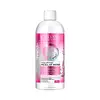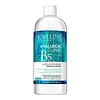What's inside
What's inside
 Key Ingredients
Key Ingredients

 Benefits
Benefits

 Concerns
Concerns

 Ingredients Side-by-side
Ingredients Side-by-side

Water
Skin ConditioningPEG-6 Caprylic/Capric Glycerides
EmulsifyingPropanediol
SolventHyaluronic Acid
HumectantAllantoin
Skin ConditioningPanthenol
Skin ConditioningCucumis Sativus Fruit Extract
EmollientHydrolyzed Glycosaminoglycans
HumectantXylitol
HumectantGlucose
HumectantXylitylglucoside
HumectantAnhydroxylitol
HumectantCetrimonium Bromide
AntimicrobialHydroxyacetophenone
AntioxidantLevulinic Acid
PerfumingSodium Levulinate
Skin ConditioningTetrasodium Glutamate Diacetate
Glycerin
HumectantPropylene Glycol
HumectantCitric Acid
BufferingWater, PEG-6 Caprylic/Capric Glycerides, Propanediol, Hyaluronic Acid, Allantoin, Panthenol, Cucumis Sativus Fruit Extract, Hydrolyzed Glycosaminoglycans, Xylitol, Glucose, Xylitylglucoside, Anhydroxylitol, Cetrimonium Bromide, Hydroxyacetophenone, Levulinic Acid, Sodium Levulinate, Tetrasodium Glutamate Diacetate, Glycerin, Propylene Glycol, Citric Acid
Water
Skin ConditioningPEG-6 Caprylic/Capric Glycerides
EmulsifyingOlive Oil PEG-7 Esters
EmollientCaprylyl/Capryl Glucoside
CleansingTetrasodium Glutamate Diacetate
Panthenol
Skin ConditioningCapryloyl Glycine
CleansingXylitylglucoside
HumectantHexylene Glycol
EmulsifyingParfum
MaskingCetrimonium Bromide
AntimicrobialCentella Asiatica Extract
CleansingCentella Asiatica Oil
AntimicrobialCalcium Citrate
BufferingPentylene Glycol
Skin ConditioningGlycerin
HumectantFructose
HumectantUrea
BufferingCitric Acid
BufferingSodium Hydroxide
BufferingMaltose
MaskingSodium PCA
HumectantSodium Chloride
MaskingSodium Lactate
BufferingTrehalose
HumectantAllantoin
Skin ConditioningSodium Hyaluronate
HumectantGlucose
HumectantMaris Aqua
HumectantHydrolyzed Algin
Sucrose
HumectantPhenethyl Alcohol
MaskingSodium Benzoate
MaskingDMDM Hydantoin
PreservativeIodopropynyl Butylcarbamate
PreservativeWater, PEG-6 Caprylic/Capric Glycerides, Olive Oil PEG-7 Esters, Caprylyl/Capryl Glucoside, Tetrasodium Glutamate Diacetate, Panthenol, Capryloyl Glycine, Xylitylglucoside, Hexylene Glycol, Parfum, Cetrimonium Bromide, Centella Asiatica Extract, Centella Asiatica Oil, Calcium Citrate, Pentylene Glycol, Glycerin, Fructose, Urea, Citric Acid, Sodium Hydroxide, Maltose, Sodium PCA, Sodium Chloride, Sodium Lactate, Trehalose, Allantoin, Sodium Hyaluronate, Glucose, Maris Aqua, Hydrolyzed Algin, Sucrose, Phenethyl Alcohol, Sodium Benzoate, DMDM Hydantoin, Iodopropynyl Butylcarbamate
Ingredients Explained
These ingredients are found in both products.
Ingredients higher up in an ingredient list are typically present in a larger amount.
Allantoin is a soothing ingredient known for its protective and moisturizingg properties. Because of this, it is often added to products with strong active ingredients.
Studies show higher concentrations of this ingredient can promote wound healing.
Though it can be derived from the comfrey plant, allantoin is produced synthetically for cosmetic products to ensure purity.
Learn more about AllantoinCetrimonium Bromide is a preservative.
Citric Acid is an alpha hydroxy acid (AHA) naturally found in citrus fruits like oranges, lemons, and limes.
Like other AHAs, citric acid can exfoliate skin by breaking down the bonds that hold dead skin cells together. This helps reveal smoother and brighter skin underneath.
However, this exfoliating effect only happens at high concentrations (20%) which can be hard to find in cosmetic products.
Due to this, citric acid is usually included in small amounts as a pH adjuster. This helps keep products slightly more acidic and compatible with skin's natural pH.
In skincare formulas, citric acid can:
While it can provide some skin benefits, research shows lactic acid and glycolic acid are generally more effective and less irritating exfoliants.
Most citric acid used in skincare today is made by fermenting sugars (usually from molasses). This synthetic version is identical to the natural citrus form but easier to stabilize and use in formulations.
Read more about some other popular AHA's here:
Learn more about Citric AcidGlucose is a simple sugar and is the most important source of energy in all organisms.
In skincare, glucose is used to hydrate the skin. It also acts as a prebiotic for our natural biome.
Glucose is hydrating due to its humectant property. As a humectant, glucose draws moisture from the air and from deeper levels in the skin.
Our skin contains many sugars that act as prebiotics and help strengthen our natural microbiome. Having a healthy microbiome helps protect our skin from harmful bacteria and other contaminants.
Studies show glucose may help with fading discoloration and pigmentation. This is because our skin metabolizes glucose into lactic acid. Lactic acid is an AHA that helps exfoliate the top layer of skin.
Learn more about GlucoseGlycerin is already naturally found in your skin. It helps moisturize and protect your skin.
A study from 2016 found glycerin to be more effective as a humectant than AHAs and hyaluronic acid.
As a humectant, it helps the skin stay hydrated by pulling moisture to your skin. The low molecular weight of glycerin allows it to pull moisture into the deeper layers of your skin.
Hydrated skin improves your skin barrier; Your skin barrier helps protect against irritants and bacteria.
Glycerin has also been found to have antimicrobial and antiviral properties. Due to these properties, glycerin is often used in wound and burn treatments.
In cosmetics, glycerin is usually derived from plants such as soybean or palm. However, it can also be sourced from animals, such as tallow or animal fat.
This ingredient is organic, colorless, odorless, and non-toxic.
Glycerin is the name for this ingredient in American English. British English uses Glycerol/Glycerine.
Learn more about GlycerinPanthenol is a common ingredient that helps hydrate and soothe the skin. It is found naturally in our skin and hair.
There are two forms of panthenol: D and L.
D-panthenol is also known as dexpanthenol. Most cosmetics use dexpanthenol or a mixture of D and L-panthenol.
Panthenol is famous due to its ability to go deeper into the skin's layers. Using this ingredient has numerous pros (and no cons):
Like hyaluronic acid, panthenol is a humectant. Humectants are able to bind and hold large amounts of water to keep skin hydrated.
This ingredient works well for wound healing. It works by increasing tissue in the wound and helps close open wounds.
Once oxidized, panthenol converts to pantothenic acid. Panthothenic acid is found in all living cells.
This ingredient is also referred to as pro-vitamin B5.
Learn more about PanthenolThis ingredient is derived from caprylic and capric acids. It is an emulsifier with emollient properties.
According to the manufacturer, it is hydrophilic and soluble in aqueous solutions (water). They also state this ingredient is stable in a medium pH range (~5 - 8).
As an emulsifier, it helps make oils and oil-soluble ingredients more soluble in water.
Learn more about PEG-6 Caprylic/Capric GlyceridesTetrasodium Glutamate Diacetate is a chelating agent. Chelating agents help prevent metal ions from binding to other ingredients. This helps prevent unwanted effects and reactions from a product. These metal ions may come from water and are found in miniscule amounts.
Tetrasodium Glutamate Diacetate can also help other preservatives be more effective.
Water. It's the most common cosmetic ingredient of all. You'll usually see it at the top of ingredient lists, meaning that it makes up the largest part of the product.
So why is it so popular? Water most often acts as a solvent - this means that it helps dissolve other ingredients into the formulation.
You'll also recognize water as that liquid we all need to stay alive. If you see this, drink a glass of water. Stay hydrated!
Learn more about WaterXylitylglucoside is created from xylitol and glucose, two humectants.
Not surprisingly, this ingredient is also a humectant. It attracts and holds water in your skin, helping to maintain hydration.
This ingredient is most commonly found in a popular trio called Aquaxyl. Aquaxyl is made up of anhydroxylitol(24 - 34%), xylitylglucoside (35 - 50%), and xylitol (5 - 15%).
According to a manufacturer, Aquaxyl is known for a 3-D hydration concept and an anti-dehydration shield to reinforce the outer layer of skin.
Learn more about Xylitylglucoside